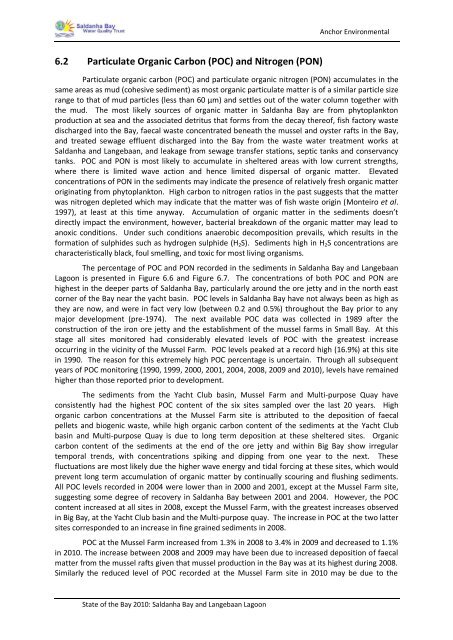State of the Bay Report 2010-Final - Anchor Environmental
State of the Bay Report 2010-Final - Anchor Environmental
State of the Bay Report 2010-Final - Anchor Environmental
Create successful ePaper yourself
Turn your PDF publications into a flip-book with our unique Google optimized e-Paper software.
6.2 Particulate Organic Carbon (POC) and Nitrogen (PON)<br />
<strong>State</strong> <strong>of</strong> <strong>the</strong> <strong>Bay</strong> <strong>2010</strong>: Saldanha <strong>Bay</strong> and Langebaan Lagoon<br />
<strong>Anchor</strong> <strong>Environmental</strong><br />
Particulate organic carbon (POC) and particulate organic nitrogen (PON) accumulates in <strong>the</strong><br />
same areas as mud (cohesive sediment) as most organic particulate matter is <strong>of</strong> a similar particle size<br />
range to that <strong>of</strong> mud particles (less than 60 µm) and settles out <strong>of</strong> <strong>the</strong> water column toge<strong>the</strong>r with<br />
<strong>the</strong> mud. The most likely sources <strong>of</strong> organic matter in Saldanha <strong>Bay</strong> are from phytoplankton<br />
production at sea and <strong>the</strong> associated detritus that forms from <strong>the</strong> decay <strong>the</strong>re<strong>of</strong>, fish factory waste<br />
discharged into <strong>the</strong> <strong>Bay</strong>, faecal waste concentrated beneath <strong>the</strong> mussel and oyster rafts in <strong>the</strong> <strong>Bay</strong>,<br />
and treated sewage effluent discharged into <strong>the</strong> <strong>Bay</strong> from <strong>the</strong> waste water treatment works at<br />
Saldanha and Langebaan, and leakage from sewage transfer stations, septic tanks and conservancy<br />
tanks. POC and PON is most likely to accumulate in sheltered areas with low current strengths,<br />
where <strong>the</strong>re is limited wave action and hence limited dispersal <strong>of</strong> organic matter. Elevated<br />
concentrations <strong>of</strong> PON in <strong>the</strong> sediments may indicate <strong>the</strong> presence <strong>of</strong> relatively fresh organic matter<br />
originating from phytoplankton. High carbon to nitrogen ratios in <strong>the</strong> past suggests that <strong>the</strong> matter<br />
was nitrogen depleted which may indicate that <strong>the</strong> matter was <strong>of</strong> fish waste origin (Monteiro et al.<br />
1997), at least at this time anyway. Accumulation <strong>of</strong> organic matter in <strong>the</strong> sediments doesn’t<br />
directly impact <strong>the</strong> environment, however, bacterial breakdown <strong>of</strong> <strong>the</strong> organic matter may lead to<br />
anoxic conditions. Under such conditions anaerobic decomposition prevails, which results in <strong>the</strong><br />
formation <strong>of</strong> sulphides such as hydrogen sulphide (H2S). Sediments high in H2S concentrations are<br />
characteristically black, foul smelling, and toxic for most living organisms.<br />
The percentage <strong>of</strong> POC and PON recorded in <strong>the</strong> sediments in Saldanha <strong>Bay</strong> and Langebaan<br />
Lagoon is presented in Figure 6.6 and Figure 6.7. The concentrations <strong>of</strong> both POC and PON are<br />
highest in <strong>the</strong> deeper parts <strong>of</strong> Saldanha <strong>Bay</strong>, particularly around <strong>the</strong> ore jetty and in <strong>the</strong> north east<br />
corner <strong>of</strong> <strong>the</strong> <strong>Bay</strong> near <strong>the</strong> yacht basin. POC levels in Saldanha <strong>Bay</strong> have not always been as high as<br />
<strong>the</strong>y are now, and were in fact very low (between 0.2 and 0.5%) throughout <strong>the</strong> <strong>Bay</strong> prior to any<br />
major development (pre-1974). The next available POC data was collected in 1989 after <strong>the</strong><br />
construction <strong>of</strong> <strong>the</strong> iron ore jetty and <strong>the</strong> establishment <strong>of</strong> <strong>the</strong> mussel farms in Small <strong>Bay</strong>. At this<br />
stage all sites monitored had considerably elevated levels <strong>of</strong> POC with <strong>the</strong> greatest increase<br />
occurring in <strong>the</strong> vicinity <strong>of</strong> <strong>the</strong> Mussel Farm. POC levels peaked at a record high (16.9%) at this site<br />
in 1990. The reason for this extremely high POC percentage is uncertain. Through all subsequent<br />
years <strong>of</strong> POC monitoring (1990, 1999, 2000, 2001, 2004, 2008, 2009 and <strong>2010</strong>), levels have remained<br />
higher than those reported prior to development.<br />
The sediments from <strong>the</strong> Yacht Club basin, Mussel Farm and Multi-purpose Quay have<br />
consistently had <strong>the</strong> highest POC content <strong>of</strong> <strong>the</strong> six sites sampled over <strong>the</strong> last 20 years. High<br />
organic carbon concentrations at <strong>the</strong> Mussel Farm site is attributed to <strong>the</strong> deposition <strong>of</strong> faecal<br />
pellets and biogenic waste, while high organic carbon content <strong>of</strong> <strong>the</strong> sediments at <strong>the</strong> Yacht Club<br />
basin and Multi-purpose Quay is due to long term deposition at <strong>the</strong>se sheltered sites. Organic<br />
carbon content <strong>of</strong> <strong>the</strong> sediments at <strong>the</strong> end <strong>of</strong> <strong>the</strong> ore jetty and within Big <strong>Bay</strong> show irregular<br />
temporal trends, with concentrations spiking and dipping from one year to <strong>the</strong> next. These<br />
fluctuations are most likely due <strong>the</strong> higher wave energy and tidal forcing at <strong>the</strong>se sites, which would<br />
prevent long term accumulation <strong>of</strong> organic matter by continually scouring and flushing sediments.<br />
All POC levels recorded in 2004 were lower than in 2000 and 2001, except at <strong>the</strong> Mussel Farm site,<br />
suggesting some degree <strong>of</strong> recovery in Saldanha <strong>Bay</strong> between 2001 and 2004. However, <strong>the</strong> POC<br />
content increased at all sites in 2008, except <strong>the</strong> Mussel Farm, with <strong>the</strong> greatest increases observed<br />
in Big <strong>Bay</strong>, at <strong>the</strong> Yacht Club basin and <strong>the</strong> Multi-purpose quay. The increase in POC at <strong>the</strong> two latter<br />
sites corresponded to an increase in fine grained sediments in 2008.<br />
POC at <strong>the</strong> Mussel Farm increased from 1.3% in 2008 to 3.4% in 2009 and decreased to 1.1%<br />
in <strong>2010</strong>. The increase between 2008 and 2009 may have been due to increased deposition <strong>of</strong> faecal<br />
matter from <strong>the</strong> mussel rafts given that mussel production in <strong>the</strong> <strong>Bay</strong> was at its highest during 2008.<br />
Similarly <strong>the</strong> reduced level <strong>of</strong> POC recorded at <strong>the</strong> Mussel Farm site in <strong>2010</strong> may be due to <strong>the</strong>

















